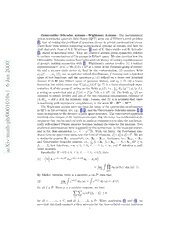
Osterwalder-Schrader axioms - Wightman Axioms PDF
Preview Osterwalder-Schrader axioms - Wightman Axioms
Osterwalder–Schrader axioms—Wightman Axioms—The mathematical axiomsystemsforquantumfieldtheory(QFT)grewoutofHilbert’s sixthproblem [6], that of stating the problems ofquantum theory in precisemathematical terms. There have been several competing mathematical systems of axioms, and here we shall deal with those of A.S. Wightman [5] and of K. Osterwalder and R. Schrader [4], stated in historical order. They are centered around group symmetry, relative tounitaryrepresentationsofLiegroupsinHilbertspace. We alsomentionhowthe Osterwalder–Schraderaxiomshaveinfluencedthetheoryofunitaryrepresentations 0 of groups, making connection with [3]. Wightman’s axioms involve: (1) a unitary 0 representationU of G:=SL(2,C)⋊R4 as a coverofthe Poincar´egroupof relativ- 0 2 ity, and a vacuum state vector ψ0 fixed by the representation, (2) quantum fields ϕ (f),...,ϕ (f), say, as operator-valueddistributions, f running over a specified n 1 n space of test functions, and the operators ϕ (f) defined on a dense and invariant a i J domain D in H (the Hilbert space of quantum states), and ψ D, (3) a trans- 6 formation law which states that U(g)ϕj(f)U g−1 is a finite0-d∈imensional repre- sentation R of the group G acting on the fields(cid:0)ϕ (f(cid:1)), i.e., R g−1 ϕ (g[f]), i i ji i 1 g acting on space-time and g[f](x) = f g−1x , x R4. (4P) The fi(cid:0)elds(cid:1)ϕ (f) are v ∈ j assumed to satisfy locality and one of th(cid:0)e two(cid:1)canonical commutation relations of 0 1 [A,B]± = AB BA, for fermions, resp., bosons; and (5) it is assumed that there ± 0 is scattering with asymptotic completeness, in the sense H=Hin =Hout. 1 The Wightmanaxiomswere the basisfor many ofthe spectaculardevelopments 0 inQFTintheseventies,see,e.g.,[1,2],andtheOsterwalder–Schraderaxioms[3,4] 0 0 cameinresponsetothedictatesofpathspacemeasures. Theconstructiveapproach / involvedsomevariantoftheFeynmanmeasure. Butthelatterhasmathematicaldi- h vergencesthatcanberesolvedwithananalyticcontinuationsothatthemathemat- p - icallywell-definedWiener measurebecomesinsteadthe basisforthe analysis. Two h analyticalcontinuations were suggestedin this connection: in the mass-parameter, t a and in the time-parameter, i.e., t √ 1t. With the latter, the Newtonian qua- m draticformonspace-timeturnsint7→othe−formofrelativity,x2+x2+x2 t2. Weget 1 2 3− v: a stochastic process Xt: symmetric, i.e., Xt ∼ X−t; stationary, i.e., Xt+s ∼ Xs; and Osterwalder–Schrader positive, i.e., f X f X f X dP 0, i Ω 1 ◦ t1 2 ◦ t2 ··· n ◦ tn ≥ X f ,...,f test functions, < t t R t < , and P denoting a path 1 n 1 2 n −∞ ≤ ≤ ··· ≤ ∞ r space measure. a Specifically: If t/2<t t t <t/2, then 1 2 n − ≤ ≤···≤ (1) Ω A e−(t2−t1)HˆA e−(t3−t2)HˆA A Ω 1 2 3 n D ··· E n = lim A (q(t )) dµ (q( )). t→∞Z Y k k t · k=1 By Minlos’ theorem, there is a measure µ on ′ such that D (2) lim eiq(f)dµ (q)= eiq(f)dµ(q)=:S(f) t→∞Z t Z for all f . Since µ is a positive measure, we have ∈D c¯ c S f f¯ 0 k l k l − ≥ Xk Xl (cid:0) (cid:1) for all c ,...,c C, and all f ,...,f . When combining (1) and (2), we 1 n 1 n ∈ ∈ D notethatthislimit-measureµthenaccountsforthetime-orderedn-pointfunctions 1 2 which occur on the left-hand side in formula (1). This observation is further used in the analysis of the stochastic process X , X (q)=q(t). But, more importantly, t t it can be checked from the construction that we also have the following reflection positivity: Let (θf)(s):=f( s), f , s R, and set − ∈D ∈ = f f real valued, f(s)=0 for s<0 . + D { ∈D| } Then c¯ c S(θ(f ) f ) 0 k l k l − ≥ XX k l forallc ,...,c C,andallf ,...,f , whichisone versionofOsterwalder– 1 n 1 n + ∈ ∈D Schrader positivity. SincetheKillingformofLietheorymayserveasafinite-dimensionalmetric,the Osterwalder–Schrader idea [4] turned out also to have implications for the theory of unitary representations of Lie groups. In [3], the authors associate to Riemann- iansymmetricspacesG/K oftube domaintype,adualitybetweencomplementary series representations of G on one side, and highest weight representations of a c-dual Gc on the other side. The duality G Gc involves analytic continua- ↔ tion, in a sense which generalizes t √ 1t, and the reflection positivity of the 7→ − Osterwalder–Schrader axiom system. What results is a new Hilbert space where thenewrepresentationofGc is“physical”inthe sensethatthereispositiveenergy andcausality,thelatterconceptbeingdefinedfromcertainconesintheLiealgebra of G. Aunitaryrepresentationπ actingonaHilbertspaceH(π)issaidtobereflection symmetric if there is a unitary operator J :H(π) H(π) such that → R1) J2 =id. R2) Jπ(g)=π(τ(g))J, g G, ∈ where τ Aut(G), τ2 =id, and H := g G τ(g)=g . ∈ { ∈ | } A closed convex cone C q is hyperbolic if Co = and if adX is semisimple ⊂ 6 ∅ with real eigenvalues for every X Co. ∈ Assume the following for (G,π,τ,J): PR1) π is reflection symmetric with reflection J. PR2) Thereis anH-invarianthyperbolicconeC q suchthat S(C)=HexpC ⊂ is a closed semigroup and S(C)o =HexpCo is diffeomorphic to H Co. × PR3) There is a subspace 0 = K H(π) invariant under S(C) satisfying the 0 6 ⊂ positivity condition v v := v J(v) 0, v K . h iJ h i≥ ∀ ∈ 0 Assume that (π,C,H,J) satisfies (PR1)–(PR3). Then the following hold: 1) S(C)actsvias π˜(s)bycontractionsonK(=theHilbertspaceobtained 7→ by completion of K in the norm from (PR3)). 0 2) LetGc bethesimplyconnectedLiegroupwithLiealgebragc. Thenthere exists a unitary representation π˜c of Gc such that dπ˜c(X) = dπ˜(X) for X handidπ˜c(Y)=dπ˜(iY)forY C,whereh:= X g τ(X)=X . ∈ ∈ { ∈ | } 3) The representationπ˜c is irreducible if and only if π˜ is irreducible. 3 References [1] Glimm, J., and Jaffe, A.: Quantum field theory and statistical mechanics (a collection of papers),Birkha¨user,Boston,1985. [2] Glimm,J.,andJaffe,A.: Quantum physics (2nded.),Springer-Verlag,NewYork,1987. [3] Jorgensen,P.E.T.,andO´lafsson,G.: ‘UnitaryrepresentationsofLiegroupswithreflection symmetry’,J. Funct. Anal. 158(1998), 26–88. [4] Osterwalder, K., and Schrader, R.: ‘Axioms for Euclidean Green’s functions’, Comm. Math. Phys.31(1973), 83–112; 42(1975), 281–305. [5] Streater, R.F., and Wightman A.S.: PCT, spin and statistics, and all that, W.A. Ben- jamin,Inc.,NewYork,1964. [6] Wightman,A.S.: ‘Hilbert’ssixthproblem: Mathematicaltreatmentoftheaxiomsofphysics’, inF.E.Browder(ed.): Vol.28(part1)ofProc.Symp.PureMath.,Amer.Math.Soc.,1976, pp.241–268. Palle E.T. Jorgensen: jorgen@math.uiowa.edu Gestur O´lafsson: olafsson@math.lsu.edu
